Modernization of MBT with the aim of increasing their combat effectiveness in urban environments
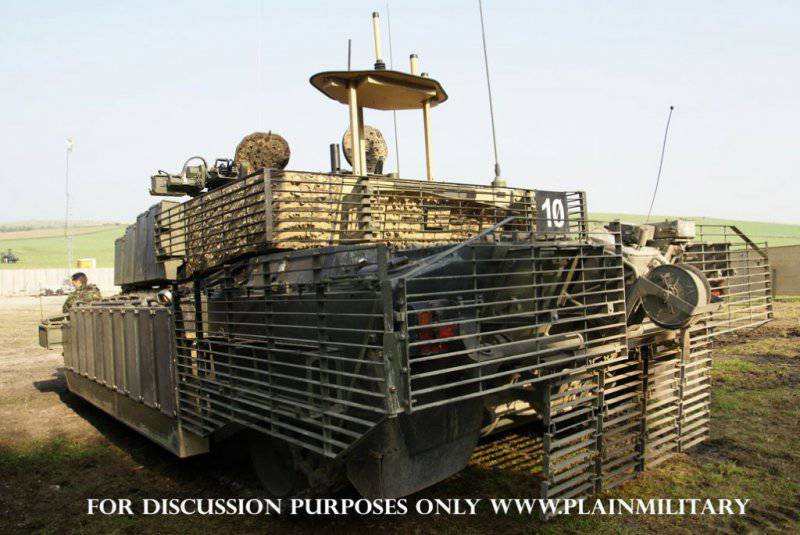
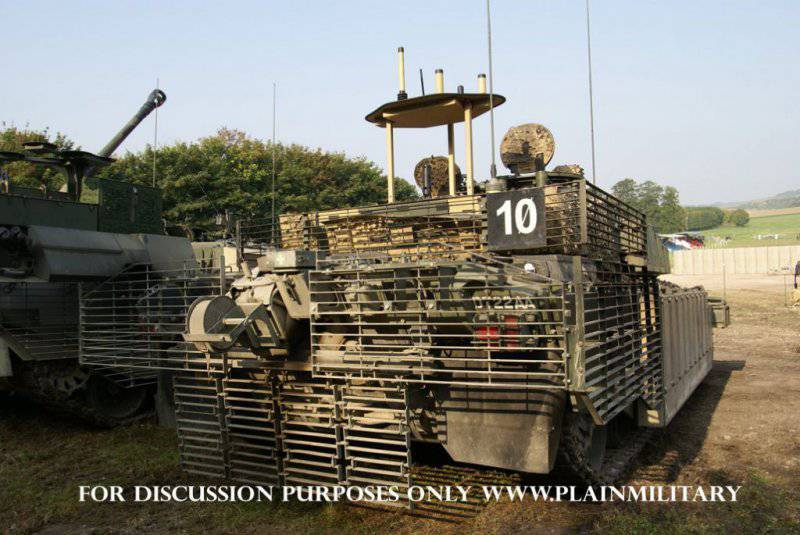
The newest OBT Challenger 2 has a significant number of improvements regarding survivability, including lattice armor in the rear part
The traditional field of action of the main combat tanks (MBT) - an open area, and although it is still relevant, however, recent operations have shown that tanks are a powerful tool in the conduct of hostilities in the city. The article discusses international developments whose purpose is to create tanks more suitable for war in built-up areas.
The main task of the main battle tanks has always been to fire and destroy other MBTs on the battlefield, and for many countries this is still the main task.
However, the Russian experience in Chechnya, operations in the Balkans, recent Western operations in the Middle East and other places have shown that MBT is a very flexible weapon system, which plays an important role not only in urban combat, but also in counterinsurgency operations.
In order to remain combat-ready in urban environments, tanks must be modified in three key areas: survivability, firepower and situational awareness. There is a wide range of options for such modifications, and although some approaches are universal, there are a number of individual solutions that are identified with specific theaters of war (theater of operations).
Traditionally, the highest level of protection of the OBT has always been in a frontal arc from 60 to 90 degrees, but when fighting in the city, they can attack from anywhere, including above and below. In this regard, many OBT was installed additional armor on the body and in some cases also on the tower. As for the hull, here the onboard booking now protects not only the driver’s compartment in front of the car, but also expands more and more towards the stern to protect the crew compartment. Currently, tank feeds often have anti-tank protection. weapons, for example, widespread grenades RPG-7 rocket launcher.
Another direction is the installation of dynamic protection units (DZ), which have long been installed on most Russian MBTs in order to increase their survivability along the frontal arc. Currently, DZ is also part of the TUSK (Urban Survival Kit) tank survival kit kit installed on the American MBT M1A1 / M1A2. The main disadvantage of DZ is that it can be potentially dangerous and can injure dismounted infantry, located near the machine. The Israeli army has equipped many of its old tanks with active armor, but the Merkava Mk 4, currently produced by MBT, has a passive booking system; its components are modular and this allows you to remove and replace blocks, depending on the combat conditions or the development of reservation technology.
Some MBTs were also equipped with anti-tank mine protection, but this can be an expensive exercise due to the fact that it involves modifying armor on vehicles with relatively low ground clearance and not intended for this. Krauss-Maffei Wegmann developed a mine protection kit for the Leopard 2A6 tank, designated 2A6M, which mainly consists of additional bottom plates. This initially met the requirements of Germany and the Netherlands, but the Canadian army also leased 20 German tanks Leopard 2A6M, of which 19 was deployed in Afghanistan.
In general, virtually all tanks involved in Afghanistan and Iraq were equipped with various electronic devices to neutralize improvised explosive devices (IEDs).
MBT protection can be further improved by installing an opto-electronic countermeasure complex or an active protection complex along with a fire extinguishing and explosion suppression system in order to increase the survivability of the crew if the complex does not work properly and the vehicle is hit.
Different seats are available to improve crew protection. For many years, the driver’s seat of Russian tanks was attached to the roof rather than to the bottom in order to increase its survivability, and some countries are now replacing their usual seats for all crew members with Autoflug seats that are attached to the sides and the roof and do not have contact with bottom.
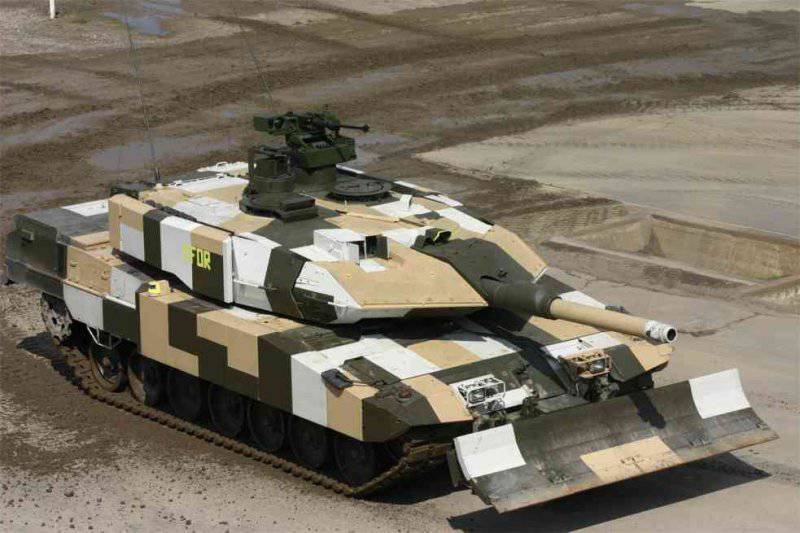
Tank Leopard 2 PSO, equipped with a front dozer blade, with camouflage for urban conditions and a remotely controlled combat module with an 12,7-mm machine gun
Enhance firepower
With regard to firepower, urban operations offer a set of goals different from the traditional set for MBT and tank ammunition is not always suitable for the task. Most of the Western MBT usually shoot two types of ammunition from their 120-mm smoothbore guns: sabot armor-piercing (APFSDS) and universal cumulative anti-tank (HEAT-MP). Russian MBTs also shoot APFSDS, but their second high-explosive fragmentation projectile (HE-FRAG) and the recent Russian development is a high-explosive fragmentation projectile that can be programmed to different ranges by means of an OMS and which is considered as a means of attacking targets for cover.
A number of other countries have now begun to acquire similar projectiles, some of which can be programmed to explode over the entrenched infantry in order to maximize impact. Skull shells are highly effective against infantry as well as for neutralizing barbed wire obstacles. Israel Military Industries has developed and launched the Anti-Personnel / Anti-Material (ARAM) projectile / for defeating the materiel, which produces a number of lethal submunitions during horizontal flight to create a highly efficient zone approximately 50 m long and 20 m wide. The first entry to the troops was a shot for the 105-mm rifled gun and then a projectile for the 120-mm smooth-bore gun.
The British Challenger 2 tanks retain their L120 30-mm rifled guns, which, in addition to APFSDS, can also fire a high-explosive projectile with crushable warhead (HESH), well suited for urban operations, as it is effective in breaking through walls. Another popular way to destroy fences is to install a dozer blade at MBT. He also showed his effectiveness in clearing city blockages; in Afghanistan, with the help of his body, he ditched pits and cleared paths so that the cars following him would quickly move forward. In some cases, these dozer blades may be replaced by plow or roller type clearance systems, which are used in conjunction with mines in front of the machine.
Self-defense capabilities can be improved by installing a remote-controlled combat module on the roof with a 7,62-mm, 12,7-mm machine gun or 40-mm automatic grenade launcher, which the loader usually works with. This provides significant advantages in areas where there is a high risk of sniping at snipers, which forces the crew to work under armor protection while reducing the level of situational awareness.
Finding an opponent can be challenging in an urban environment and good situational awareness is vital, especially when you are in a tank with batten hatches. Apart from the tank commander, who often has a stabilized panoramic sight mounted on the roof, turning 360 degrees, optoelectronic devices for the driver, gunner and loader usually cover the frontal arc, although some of the most recent MBTs are also equipped with rear-view cameras so that The driver can take back safely. However, there are several ways to improve the situational awareness of the crew, tanks can be equipped with a camera on the mast or a group of compact cameras that are installed in the front, side and aft, while the picture is displayed on the display, as is done in the newest Merkava Mk 4.
However, some electro-optic devices are vulnerable to small arms bullets and shell splinters, and some cars were equipped with flaps that close the devices when they are not needed, although this is only a half-measure.
Limited elevation and declination angles can make it difficult for tanks to fire at the enemy, both in close combat and in high buildings, but, at least for MBT, electrically operated grenade launchers, usually firing smoke grenades or other means, usually have masking. Some countries rework them to shoot frag grenades to protect against infantry in urban environments.
Instead of direct visual exchange, modern MBTs have a battle management system for quick information exchange, as well as a comprehensive communication system. For melee with dismounted infantry, many MBTs deployed in urban or counterinsurgency operations are equipped with a telephone in the rear and a “smart” internal communication that provides wireless communication for the infantry with the crew of the tank.
French design
Some machines are quite interesting systems. Necter's Leclerc MBT option, which France acquired 406 machines, is specifically designed for urban operations and is named Leclerc Action en Zone Urbaine (AZUR). It was shown for the first time in the middle of 2006, and was evaluated by the French army at the end of 2006 and the beginning of 2007.
The onboard screens of the standard Leclerc MBT protect only the front of the chassis, but the new screen of modular composite armor was installed on AZUR, where it was extended from the front of the chassis to the end of the fighting compartment. The rest from the sides and the stern is protected by lattice armor, and the roof of the aft engine compartment has been upgraded to provide increased protection against incendiary bottles. The panoramic camera is mounted on the roof to provide the tank commander with a quick all-round view, the remote-controlled 7,62-mm machine gun is mounted on the roof, guidance and shooting are conducted from inside the tank. The tank also has seven GALIX grenade launchers on each side of the turret, which fire smoke grenades GALIX 4. In addition to the standard APFSDS and HEAT ammunition, the 120-mm smoothbore gun can also fire with the newly developed high-explosive Nexter Munitions 120 HE F1 high-explosive ammunition. It was developed under a contract with an arms procurement agency, ordered 10000 of such shots.
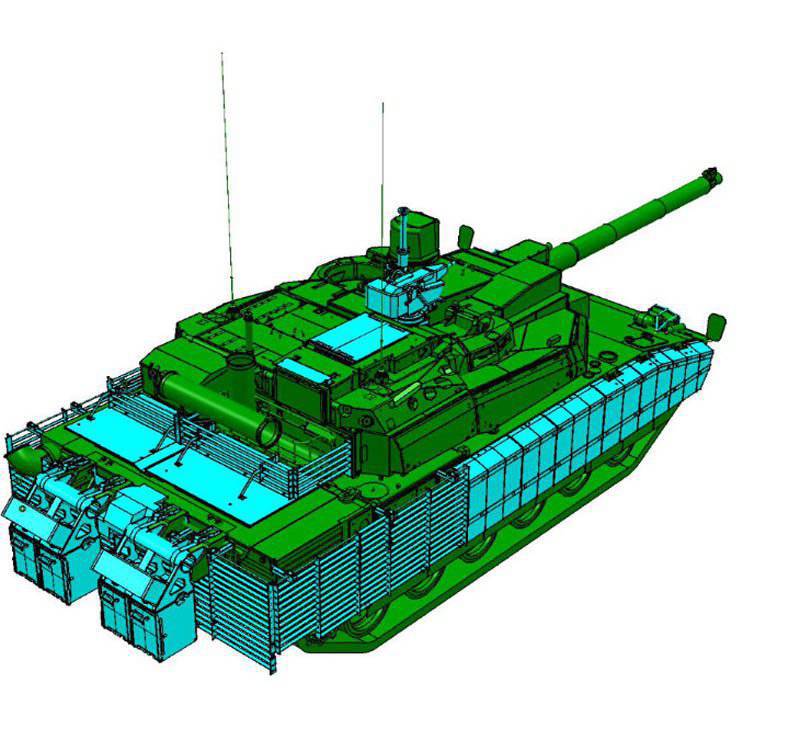
Image of Leclerc MBT from the stern; tank upgraded for urban conditions, changes are shown in blue
The Leclerc MBT MBT usually has two additional tanks for diesel fuel, but they were removed from the AZUR tank and replaced with two drop boxes in which ammunition or allowance for dismounted infantry can be transported. The infantry has a direct communication channel with the crew of the Leclerc tank through a short-range communication system.
According to Nexter Systems, the AZUR kit is modular, and users can select the parts that fit their requirements. In this regard, the entire kit can be installed on the machine in less than half a day using standard tools and equipment.
Further improvements in survivability may include the installation of an active protection complex, possibly using Nexter Systems' KBCM (Kit Basique de Contre-Mesures) experience, which was tested on the AMX-10RC 6x6 reconnaissance vehicle at the beginning of 2000-x.
In total, the Leclerc 254 machines of the French army will undergo a medium modernization (installation of the AZUR kit), the first vehicles will be re-commissioned in the 2015 year. According to Nexter, the upgrade could be forced and tanks deployed ahead of time, if operational requirements require it.
Leclerc AZUR tanks are not equipped with dynamic protection, but the French army installed DZ on some of its AMX-30B2 MBT, which are currently out of service. DZ is currently installed on an EBG engineering machine and remotely controlled demining machines based on the AMX-30 chassis.
The French army also tested two wheeled armored vehicles, upgraded for urban conditions: the VAB from Renault Trucks Defense BTR and the VBL light reconnaissance vehicle from Panhard General Defense.
Leopard PSO
Krauss-Maffei Wegmann (KMW), the main manufacturer of the widely used MBT Leopard 2, developed the Leopard 2 PSO (Peace Support Operation), which was shown to the public for the first time in the middle of 2006. In the course of development, carried out with KMW’s own funds and many other subcontractors, the wishes of a number of MBT Leopard 2 buyers were taken into account. According to KMW, the modular design of the Leopard 2 PSO allows it to be adapted to the specific requirements of the customer, some components of the kit can be quickly installed on the vehicle before being sent to the troops.
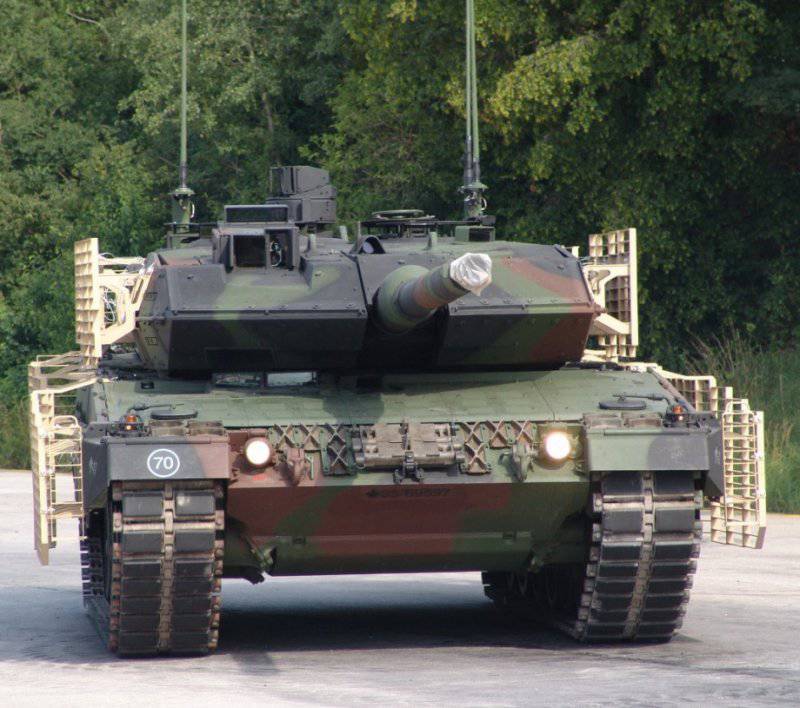
Canadian Leopard 2A6 CAN under test in Germany with grid armor on the hull and turret
Rheinmetall 120-mm L / 44 smooth-bore cannon left, but standard APFS-DS and HEAT-MP projectiles are not optimized for urban operations. To address this shortcoming, Rheinmetall Munitions has developed a new “smart” 120-mm high-explosive projectile, which will be programmed to explode the target for maximum impact on dismounted or entrenched infantry.
7,62-mm coaxial machine gun left, but also installed remotely controlled combat module for direct cover. You can install an 7,62-mm or 12,7-mm machine gun or an 40-mm automatic grenade launcher from which you can fire a loader.
All Leopard 2 MBTs have two groups of four 76-mm grenade launchers installed on each side of the tower, smoke or grenade traps are installed as standard, but you can also shoot fragmentation grenades from them to fight the infantry.
Tank Leopard 2 PSO is equipped with additional armor on the roof, as well as armor screens, extended to the stern and down on each side of the tower.
It is possible that the Leopard 2 PSO tanks will also be equipped with the 2A6M standard mine protection kit, which already stands on some Canadian, German and Swedish Leopard 2 MBT systems. A hydraulically driven bulldozer blade is installed in the front, controlled by the driver from his seat, and can be used to clear obstacles, such as road barriers and barricades.
The optics of the Leopard 2 PSO are protected so that it cannot be damaged by stones. Cameras can also be installed to increase crew situational awareness for all 360 degrees. AZEZ situational awareness system from Rheinmetall Defense Electronics has already been tested on the Leopard 2A4 tank.
While the Leopard 2 PSO can be manufactured to this specification, it seems that most buyers would prefer to redesign existing machines instead. It is possible to install new electric drives instead of the electro-hydraulic system of the standard MBT Leopard 2. An auxiliary power unit can also be installed, which will allow the subsystems to operate when the main diesel MTU diesel engine with an 1500 hp power is muted.
KMW has completed several prototypes of the Leopard 2 PSO, but so far the German army has not confirmed its purchasing plans. At one time, it was intended to upgrade a batch of 70 towers from the Leopard 2, which could be quickly installed on the existing Leopard 2 chassis.
The Canadian Army rented 20 Leopard 2A6M tanks from the German Army for use in Afghanistan to meet the urgent operational requirements (UOR). Before deployment, they were upgraded to the configuration of the Leopard 2A6M CAN, which includes the installation of Canadian communications equipment, protective screens to reduce heat signatures from Saab, cooling jackets for the crew, lattice armor on the hull and turret, and electronic equipment to combat the VCA.
The Canadian Army also rented two BihfelRHEMs manufactured by Rheinmetall Landsysteme to support its Leopard 2A6M CAN tanks deployed in Afghanistan. They were upgraded by Rheinmetall Landsysteme before shipment, additional grid armor was installed in the stern of the vehicle, Canadian communications, cooling of the crew, modified dozer blade and additional water for the crew. This upgrade also includes a new mine protection kit for Biiffel, of which Canada was the first customer.
Strengthening the protection of the tank Merkava
The Israeli MBT Merkava was originally created for normal combat operations and is currently being mass-produced the Merkava Mk 4 model. He, perhaps, has the highest level of protection among modern tanks, he has an unusual layout, the power unit is located in front, and the remaining space is given to a manned compartment.
Merkava has a high level of protection not only in the frontal arc, but also the sides and the stern. In addition to the crew of the 4 man, he can carry infantrymen, who quickly parachute from the stern.
Not one MBT can provide the crew and the landing force with 100% protection, a certain amount of MBT Merkava has been lost in recent years from the detonation of mines and anti-tank weapons. The combat experience gained in South Lebanon accelerated work to further increase the survivability of the Merkava MBT.
After intensive testing, the Israeli army has now begun to equip its MBT Merkava Mk 4 with the Rafael Advanced Defense Systems Trophy active defense system. During recent tests, he successfully intercepted 100 per cent of some types of anti-tank weapons, which increased Merkava Mk 4’s anti-tank weapons, such as the RPG-7, from all perspectives.
To work together with its MBT, Israel has developed a wide range of support vehicles on a tank chassis, including the Achzarit armored combat vehicle based on the chassis of the T-54 and T-55 tanks, the Puma engineering vehicle on the Centurion chassis. They have a high level of protection with installed systems manufactured by Rafael Advanced Defense Systems and Israel Military Industries. Both companies also offer protection kits for foreign MBTs, they have been sold to a number of countries, including Slovenia (T-55) and Turkey (M60A3).
Currently, the Namer (Tiger) heavy infantry fighting vehicle is in service, it is a completely new vehicle based on the components of the Merkava Mk 4 tank. The Iron Fist active protection complex from Israel Military Industries is installed on it.
Russian Experience
During the war in Chechnya, about 10 percent of infantry fighting vehicles deployed in Chechnya by the Russian army were lost, most in close urban combat. Since then, Russia has placed an increased emphasis on increasing the survivability of its infantry fighting vehicles, but a large number of different types of vehicles currently deployed, which the Russian army is currently trying to get rid of, have a negative impact.
Currently produced Russian MBT T-90 have advanced booking solutions, including remote sensing in a frontal arc.
Russia has developed and tested a number of defense complexes, for example, the Arena from KBP and Drozd-2 from KBM, but they, apparently, did not enter service with the Russian army.
During the hostilities in Georgia in 2008, most of the Russian army’s BMPs were obsolete, including the T-62 and T-72 and BMP-1 and BMP-2 MBTs. None of these machines was optimized, although on some T-62 lattice armor was installed on the sides of the turret to protect against RPGs.
Lattice armor was also installed on a number of other Russian BBM, mostly based on combat expediency.
Russia has been developing remote sensing equipment for many years and has the latest systems that provide protection against kinetic, high-explosive and cumulative ammunition. In addition to installing the MBT, these DZ units were also installed on the BMP-3 and offered for export.
The BMPT based on the T-90 MBT chassis (Terminator) is currently being produced in small quantities for the Russian army, the machine will usually be used to support other BBM in urban operations.
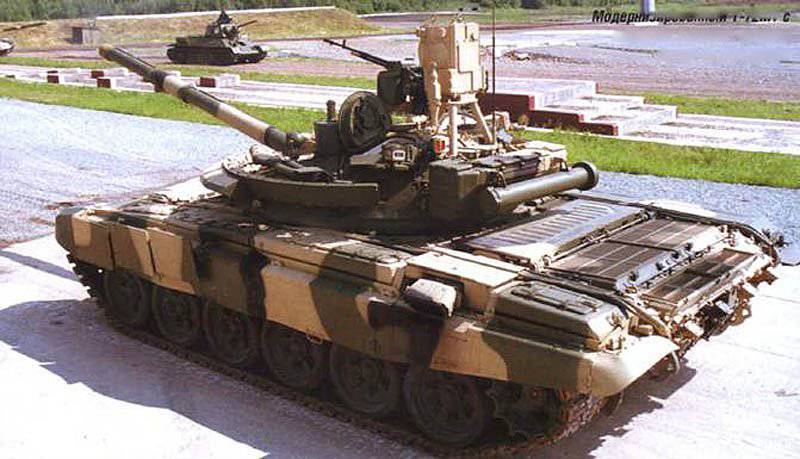
Upgraded Russian tank T-72M1 with DZ and KAZ Arena
Bold expectations
The British army at one time held an OBT company Challenger 2 from BAE Systems in the city of Basra in southern Iraq, but now after the withdrawal of troops from there, they have all been returned to Britain.
Under the leadership of BAE Systems, a number of upgrades were carried out on these Challenger 2 in order to adapt tanks to urban operations. The upgrade includes the installation of a remote-controlled combat module Enforcer from Selex Galileo in place of the loader; It was originally purchased for the Panther communications and control machine. A new set of passive armor was installed in the front of the chassis, sides of the hull and turret, and lattice armor around the stern. Also on the tower was installed additional armor.
A new passive armor in front of the hull was replaced with a DZ, which was originally developed for the Challenger 1 and installed for Operation Desert Storm. Subsequently, it was installed on the Challenger 2 tanks for operation "Iraqi Freedom" and supplemented with lattice armor.
More recently, a mine protection kit was developed and installed on the Challenger 2, as well as on the Challenger BRAM.
New night vision devices were installed for the driver and electronic suppression devices to neutralize the VCA. Other improvements include a wire cutter to protect people on the roofs of cars, an upgraded air conditioning system, and measures to reduce thermal signatures.
The main weapon is the L120 30-mm rifled gun, it shoots an APFSDS projectile with a depleted uranium tip, but for urban operations a HESH shot is preferred and is well suited for neutralizing bunkers, buildings and walls.
With the initial deployment, the Challenger 2 weighed roughly 62,5 tons, with a complete UOR retrofit kit, the mass is now approaching 73 tons with a corresponding increase in ground pressure and a decrease in power density.
During the invasion of Iraq in 2003, units of the American 1 reconnaissance division were deployed to Baghdad with Abrams tanks. In the city, tanks performed a variety of tasks, ranging from psychological restraint to covering the coalition infantry.
The standard armor of the Abrams tank is thicker in the front and is designed to protect against other combat vehicles and does not protect against circular attack in the context of an asymmetrical war that took place in Iraq and in Afghanistan.
This forced the army to install a TUSK retrofit kit on their Abrams МХNUMX series tanks.
The Army Combat Systems Directorate has teamed up with General Dynamics Land Systems to develop these retrofit kits. The first Abrams M1A1 / M1A2 tanks equipped with TUSK were deployed in the second half of 2007, the total number of sets was 505 units by the middle of 2009. Subsequently, the TUSK I was replaced by the TUSK II kit.
Other improvements include new equipment designed to improve situational awareness and enhanced bottom protection against roadside bombs to increase crew survivability.
To adapt tanks for urban battles, the original TUSK package included remote IR sights, external gun screens, armored tiles, sterned armor, a telephone for communication of the crew and dismounted infantry mounted in a box in the stern of the vehicle.
The TUSK kit is designed modular (separate systems can be enabled or excluded) to meet operational requirements. According to General Dynamics, part of the whole package is a thermal imaging loader (LTWS), which provides it with the ability to aim at night with a video signal output to a monocular.
Other upgrades related to situational awareness include a camera installed in the stern that has an 180 overview of the aft of the MBT, as well as a video amplifier to improve visibility at night and under any weather conditions. In order for all new systems to work, a switchboard was installed to protect the electrical circuits of the TUSK components.
As for enhancing protection, there is a loader flap (LAGS) made of armored glass, which protects it when working with the machine gun M240, when you need to pop out of the hatch. Included TUSK II protection expanded to 360 degrees. In both cases, the flap rotates with the machine gun on the rotary axis.
TUSK can also offer a anti-sniper / anti-combat weapon installation (CS / AMM), which provides stabilized anti-sniper fire without the need for crew members to lean out. This is the 12,7-mm machine gun M2 paired with the main Remote Thermal Sight (RTS) at the top of the 120-mm MBT gun.
Another popular component of TUSK is the CROWS remotely controlled module. It allows crew members to work with a stabilized 12,7-mm M2 machine gun from inside the machine with a joystick that can rotate the machine gun 360 degrees horizontally and vertically from -20 to + 60 degrees. M2 is targeted with a day / night sight, the picture is displayed.
In order to increase the protection of the tank sides, DZ XM32 units are installed. They are designed to combat manual weapons, which can shoot with cumulative anti-tank ammunition.
However, as you know, roadside bombs caused most of the casualties in Iraq and Afghanistan. In this regard, additional upgrades were carried out in order to increase protection against IEDs. They include increased underbody protection, a driver's seat attached to the roof, not to the bottom, and electronic countermeasures to neutralize remote-controlled improvised explosive devices.
Materials used:
Jane's International Defense Review
www.defense-update.com
www.kmweg.com
www.imi-israel.com
www.nexter-group.fr
www.tankinfo.ru
www.gdls.com
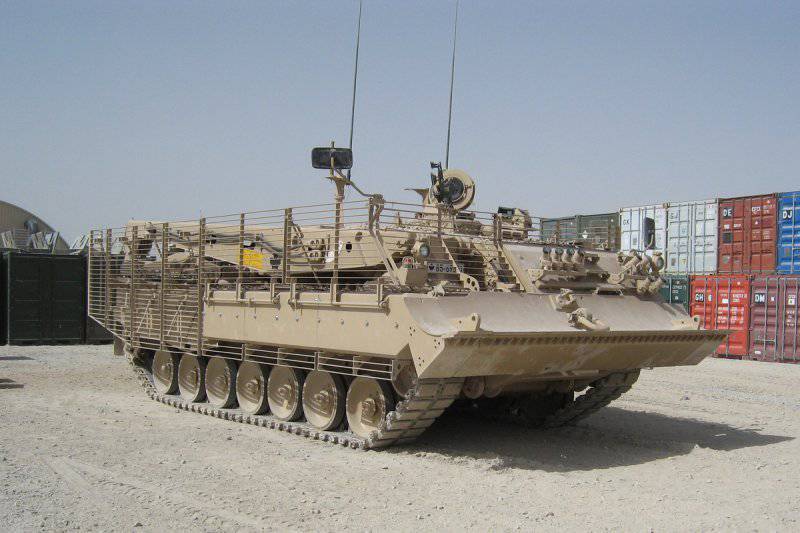
Information